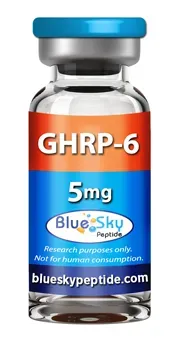GHRP-6, or growth hormone-releasing peptide 6, is a synthetic mimetic of ghrelin. This peptide is classified as a growth hormone secretagogue, initially identified for its ability to bind to the growth hormone secretagogue receptor (GHS-R). Research has confirmed that the GHS-R receptor naturally binds to ghrelin, the endogenous ligand responsible for regulating hunger, food intake, and growth hormone (GH) secretion.1 Thus, GHRP-6 is recognized as a potent ghrelin mimetic.
Unlike growth hormone-releasing hormone (GHRH), GHRP-6 does not share any amino acid sequence and binds to different receptors. However, when co-administered with GHRH, GHRP-6 exhibits synergistic effects, enhancing GH release due to its impact on both the hypothalamus and pituitary gland.2
GHRP-6 is composed of six amino acids, including two unnatural D-amino acids, and has a molecular weight of 872.45 g/mol. Its amino acid sequence is as follows:
- L-Histidine
- D-Tryptophan
- L-Alanine
- L-Tryptophan
- D-Phenylalanine
- L-Lysine
The incorporation of D-amino acids enhances the stability of GHRP-6, allowing it to stimulate GH secretion from the anterior pituitary while inhibiting somatostatin, a hormone that normally suppresses GH release. This increase in GH promotes the release of insulin-like growth factors (IGFs), which play essential roles in metabolism, protein synthesis, and cell proliferation.1
Research has demonstrated various biological effects of GHRP-6. In aquaculture, feed supplementation with GHRP-6 at doses of 100 µg/kg or 500 µg/kg has improved growth performance in fish. The lower dose enhanced aerobic metabolism, while the higher dose elevated GH levels comparable to those induced by ghrelin.1 Additionally, GHRP-6 has been studied for its neuroprotective properties; in a gerbil model of ischemic stroke, the combination of GHRP-6 and recombinant epidermal growth factor (rhEGF) improved survival rates and neurological outcomes.3
Important Notice: GHRP-6 is intended exclusively for in vitro research purposes and is not approved for human or veterinary use. It must be handled according to all applicable safety and research protocols to ensure proper use.
References
- Rodriguez-Viera L, Marti I, Martinez R, et al. Feed supplementation with the GHRP-6 peptide, a ghrelin analog, improves feed intake, growth performance, and aerobic metabolism in the gilthead sea bream Sparus aurata. Fishes. 2022;7:31.
- Popovic V, Damjanovic S, Micic D, et al. Blocked GHRP-6-induced GH secretion and absence of synergistic action with GHRH in patients with hypothalamopituitary disconnection: Evidence of hypothalamic action. J Clin Endocrinol Metab. 1995;80(3):942-947.
- Subiros N, Perez-Saad HM, Berlanga JA, et al. Assessment of dose-effect and therapeutic time window in rhEGF and GHRP-6 co-administration for stroke therapy. Neurol Res. 2016;28(3):187-195.


